Wired vs. Wireless Connections
Author’s note: While I have tried to keep any personal bias out of this post but it should still be read in the context of the idea that we would like to be preferred vendor for cable assembly and wire harness development and manufacturing.
The debate between using wireless or wired devices and networks often comes up in a few different contexts. Whether it is a personal Internet network for a home or in commercial applications like a wireless ECG/EKG monitor, technology has made it possible for numerous wireless items to reach the market. There are many business internet services out there, Primus is one example The question is whether wireless or wired options are better for the needs of the individual or company.
Comparison for Personal Use:
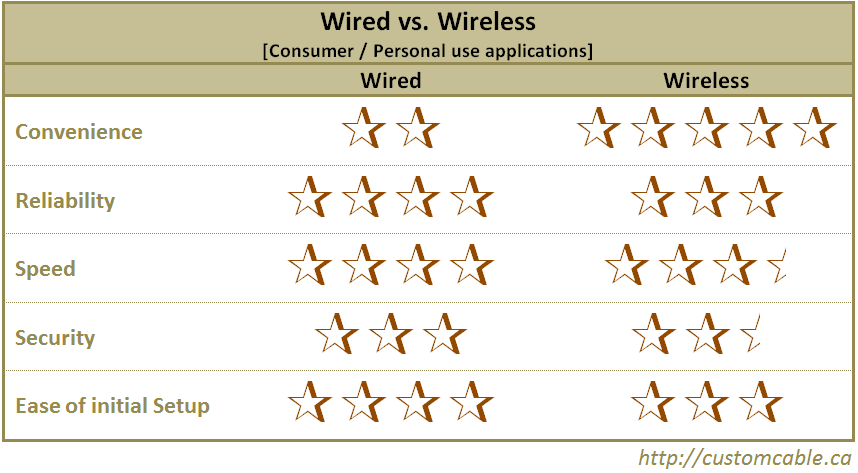
The use of a wireless router and a wireless system in a house or for personal devices like phones, MP3 players or similar portable electronics is a long-term trend. In personal use, wireless and wired options are often related to Internet usage. Both options, wired and wireless connectivity have their advantages and disadvantages that appeal on a personal level.
One of the first considerations is the level of convenience. In the case of convenience at home or on the road, wireless options are often the most convenient choice. Wireless networks can be accessed from any computer in the vicinity of the router, making it possible to connect several computers in one house. Another advantage is the ability to use wireless chargers and wireless devices while on the go. A wired connection is less versatile in personal use, so when it comes to convenience the wired options are at a disadvantage.
Security is another consideration with wired and wireless networking. In this category, wired networks are generally better because the security built into the system is better than a wireless option. Wireless will require taking some additional measures to secure the connection. That said, many wireless routers in the market today offer security settings at the click of a single button mounted on the front panel of the router or the switch. All too often, it would users own actions (visiting sites with malicious software and viruses, opening suspect emails, putting credit card information on unsecure webpages etc.) that will compromise their security before someone breaks through their WEP or WPA encryption.
Reliability is another feature to look for when determining whether to use wired or wireless connections. In the case of reliability, wired connections are generally best because interference is not an issue and speed remains steady as a result of the wire. With wireless networks one can casually walk in and out of the wireless’s range, often resulting in a dropped connection. Overall, the wireless connections do tend to be a little more fickle, often for reasons that the end user may never fully resolve.
Wired connections (@ 1000 mbps) remain at least three times faster than their wireless counter parts (@ 300 mbps) at least at the time of writing this article. Although this should have little to no impact on most end users since most residential broadband internet providers offer speeds well below the 300 mbps and at the same time, there is nothing stopping the end use from connecting their computers to the modem on as and when required basis.
In the area of personal use, wired devices have an advantage of being more secure and reliable than a wireless option. Unfortunately, in this area convenience will often outweigh the advantages of the wired options.
Comparison for Commercial Use:
While personal Internet usage and personal devices might use a wireless network, when it comes to commercial needs the determination of which system is better varies on different opinions and the needs of the products. Understanding the advantages and disadvantages of each system can make a difference between which system is better. In the case of commercial usage, or the use of commercial devices, the advantages and disadvantages might seem surprising.
One of the major considerations is the cost associated with a wire harness versus a wireless option. The wired device is infinitely less costly to develop and make, thus it is ultimately less costly to buy. When making commercial devices it is much less costly than putting together the components of a wireless system. The wired system has a clear advantage over the wireless when it comes to price, especially of the device is for a custom application and low volume.

Another consideration with wired and wireless commercial devices is the reliability. Since wireless will often have interference from other devices, the wired system is clearly superior in this instance. The design engineer or the developer would have one less variable to accommodate if they take the wired route. At the same time the designer can concentrate on the task at hand rather than spending time and resources on making a wireless system work, as well as meeting any regulatory requirements from independent bodies such as FCC. Commercial devices frequently require very reliability built into the system. The risk of losing the connection, or just degraded performance due to interference from external sources makes wireless options less advantageous.
As with any other system, wired connections are more secure than wireless options. In a commercial device, this security might make the difference between losing valuable data on the device or keeping it safe.
In commercial systems, a wired device is clearly superior to the wireless system because of the ease of product development; reliability; reasonable cost and security outweigh any minor convenience a wireless option might provide.
Comparison for Industrial Usage:
When considering whether to opt for wireless or wired solutions in an industrial setting, the factors are often different from personal usage or commercial usage. Using wired connectivity is sometimes the only available choice due to the fact that many industrial devices might not be economical to build and set up on a wireless interface.

The first consideration related to industrial devices is the development cost of wireless. Industrial devices often require the use of custom cables and wire harnesses to allow the items to work effectively. In many cases, the cost of trying to develop a wireless system that will work integrate with the existing setup could be substantial. Often, there would lie more value in adding additional features in the same budget as opposed to making an effort on reliably and securely transmitting data over the wireless. Off course here the assumption is that any such system will need to transmit the data or I/O signals in real time; often attaching laptop to such a system and re-relaying the information over the wireless would make more financial sense.
The effectiveness of the equipment is another key point that industries must consider before looking into wireless options. As with any other system, a wireless device made for industries will have the limitations of any other electronic or similar item. The problem with this is the fact that the system might have interference that makes equipment stop working when it is on a wireless system. That can result in costly delays for a production line as then the line or system would be down or the data will be buffered all the while the cause of failure and a resolution is being determined.
Industries need reliable systems and many items like a programmable logic controller or current testers cannot afford the potential reliability problems that may be introduced with the wireless option. A PLC in particular is not worth creating as a wireless system because interference from common devices like cell phones might even put lives in danger as might happen if the PLC system at an amusement park suddenly lost the connection as there was one more variable for its proper operation.
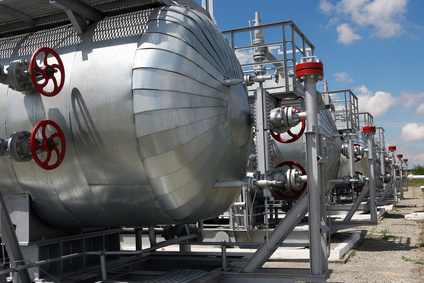
Another factor that industries must consider is security. Poor security in a wireless system can be complicated to manage on the large scale of industrial equipment or computers. This can not only become expensive, but it can result in problems like viruses that ruin the system. A cable assembly is by design more secure, so the system is easier to keep from any security breaches.For industrial use, a wired system is a better option than trying to develop wireless options. The cost of traditional wire harness options, custom cable needs and cable assembly combined with the reliability and security makes a wired system the obvious choice for industries. Wireless is not an option when it can result in danger and potentially expensive delays.
The choice between wireless and wired systems is often a matter of using common sense and weighing the pros and cons. In a personal home or individual devices, a wireless system might be the most convenient and does not have the risks of commercial and industrial equipment and devices. For those looking at a commercial device or industrial systems, wired options are generally the better choice as a result of better safety and reliability. Lets not forget that some situations can be totally unique to a point that people will try any approach for a fast data transfer, as was the case with South African company that used a pigeon to send 4Gb over sixty miles.
HDMI vs. Display Port – A Brief Comparison
There’s been a lot of talk recently about how HDMI and DisplayPort compare to one another. As two of the most cutting edge high definition interfaces currently available on the market, they are the subject of intense scrutiny from techies and consumers alike, since it seems likely that one will eventually become the industry standard while the other declines. While similar in many ways, each has some distinct advantages and disadvantages.
Physically and functionally, HDMI and DisplayPort are pretty similar. Both are cable assemblies that work through high bandwidth signalling to provide high definition TV, PC visuals, and gaming, both have fairly similar connectors, and both have some form of content protection. The biggest difference that a consumer would see between the two would be HDMI’s higher resolution capabilities, and the wireless intranet function found in HDMI 1.4.
However, as far as extensibility, convenience, and royalty structure go, the two products are quite different. HDMI products are fairly limited when it comes to extensibility, as newer products are incompatible with other ones, requiring consumers to update their entire system if they wish to change from an older HDMI product to a newer one. Additionally, HDMI products come in a confusing array of varying qualities, with HDMI 1.4 coming in six different types, each with different aspects, and each requiring a different cable connector. Finally, HDMI has a royalty structure attached to it, with a four cent royalty per unit sold, and a multi-thousand dollar lump sum fee to mass producers. This makes it more expensive to install, which can add up if a consumer has to change their entire system with every update.
Displayport, on the other hand, is both backward and forward extensible, meaning it works with both its older products and those planned for production. It is also compatible with HDMI and DVI technology. Because of its extensibility, consumers are not required to change to a new system in order to update their existing DisplayPort products, which is certainly a plus as far as convenience goes. Finally, DisplayPort is royalty-free and license-free, which makes it cheaper to produce.
Despite the advantages of DisplayPort for the consumer, HDMI is firmly established in the consumer electronics market, and unlikely to disappear soon. DisplayPort has a number of big companies backing it, including Dell, Apple, and HP, but it may have a hard time breaking into the HDTV world where HDMI currently rules. While DisplayPort’s extensibility and royalty-free nature may eventually bring it to the top, both technologies are likely to be around for at least the next five years.
There’s been a lot of talk recently about how HDMI and DisplayPort compare to one another. As two of the most cutting edge high definition interfaces currently available on the market, they are the subject of intense scrutiny from techies and consumers alike, since it seems likely that one will eventually become the industry standard while the other declines. While similar in many ways, each has some distinct advantages and disadvantages.
Physically and functionally, HDMI and DisplayPort are pretty similar. Both are cable assemblies that work through high bandwidth signalling to provide high definition TV, PC visuals, and gaming, both have fairly similar connectors, and both have some form of content protection. The biggest difference that a consumer would see between the two would be HDMI’s higher resolution capabilities, and the wireless intranet function found in HDMI 1.4.
However, as far as extensibility, convenience, and royalty structure go, the two products are quite different. HDMI products are fairly limited when it comes to extensibility, as newer products are incompatible with previous ones, requiring consumers to update their entire system if they wish to change from an older HDMI product to a newer one. Additionally, HDMI products come in a confusing array of varying qualities, with HDMI 1.4 coming in six different types, each with different aspects, and each requiring a different cable connector. Finally, HDMI has a royalty structure attached to it, with a four cent royalty per unit sold, and a multi-thousand dollar lump sum fee to mass producers. This makes it more expensive to install, which can add up if a consumer has to change their entire system with every update.
Displayport, on the other hand, is both backward and forward extensible, meaning it works with both its older products and those planned for production. It is also compatible with HDMI and DVI technology. Because of its extensibility, consumers are not required to change to a new system in order to update their existing DisplayPort products, which is certainly a plus as far as convenience goes. Finally, DisplayPort is royalty-free and license-free, which makes it cheaper to produce.
Despite the advantages of DisplayPort for the consumer, HDMI is firmly established in the consumer electronics market, and unlikely to disappear soon. DisplayPort has a number of big companies backing it, including Dell, Apple, and HP, but it may have a hard time breaking into the HDTV world where HDMI currently rules. While DisplayPort’s extensibility and royalty-free nature may eventually bring it to the top, both technologies are likely to be around for at least the next five years.
The following snapshot is from 31.3.2011, it will be interesting to see where this goes from here.

Lean vs Mass Manufacturing: A Very Brief Overview
 “Lean manufacturing” is a favorite buzzword of business conferences lately, and it’s easy for the uninitiated to be unclear on the difference between lean and mass manufacturing. In fact, they differ in many ways, from philosophy and business strategy to production models and company culture.
“Lean manufacturing” is a favorite buzzword of business conferences lately, and it’s easy for the uninitiated to be unclear on the difference between lean and mass manufacturing. In fact, they differ in many ways, from philosophy and business strategy to production models and company culture.
Lean manufacturing works on the principle of “work smarter, not harder,” and works to eliminate production waste; waste being anything that does not add any value to the final product. Common wastes include waiting time, processing, inventory, and leftovers. By eliminating waste, lean manufacturers are usually able to produce higher quality products in a shorter time.
Whereas mass manufacturing is based off of forecasts and sales, lean manufacturing works off of customer orders. This eliminates the need for warehouses, because little excess product is produced. This also keeps the company from having to sell products at a loss when they become obsolete. The most efficient lean manufacturers report more than twenty inventory turnarounds per year; most mass manufacturers report less than ten.
The culture of the two types of companies differs as well. The hierarchy of mass manufacturing companies is inflexible, and usually produces alienation between employees and managers. A lean manufacturing company has a flatter structure, and encourages broad employee participation, which creates a culture of mutual responsibility and open communication. Additionally, in mass manufacturing companies each employee tends to specialize in one area only, and only works on that particular machine or production area, while those in lean companies are widely cross-trained.
Industries that particularly benefit from lean manufacturing are usually those that exist in rapidly evolving markets or those that require a lot of know-how to produce a quality product. Technological manufacturers are one of those most fond of lean manufacturing, as a large inventory of product can quickly turn into a pile of obsolete junk as the industry changes. For example, a custom cable manufacturer could be left with reels of useless wire, or warehouses of out-of-date custom cable assemblies, which would have to be liquidated at a loss. Also, technological industries like cable assembly companies require a high level of skill from their employees to produce quality products, which can become extremely expensive under the specialist system in mass manufacturing.
Though both types of manufacturing produce results, lean manufacturing is considered more forward-thinking, and is becoming increasingly popular, particularly, as stated, in the technology industry. Although more and more companies are converting to lean manufacturing, large companies will continue to rely on mass manufacturing when quality is not a top priority and they can afford a small seasonal loss.
Why Outsource?
Outsourcing has become a hot topic in recent years. You may already be aware that the concept of outsourcing is far from a new idea. As far back as 1776, economist and philosopher Adam Smith addressed the topic is his seminal volume An Inquiry into the Nature and Causes of the Wealth of Nations. He has been quoted as saying “If a foreign country can supply us with a commodity cheaper than we ourselves can make it, it is better to buy it of them.”
 In recent years many companies have viewed outsourcing as a business fad or trend to partake in without understanding the true benefits and potential risks that outsourcing can provide their organization. Any manager or executive knows that the effective utilization of organizational resources directly impacts a business’ bottom line. Process improvement, specialization, and task proficiency may not be optimized within your business. If this is the case, you may be able to deliver a better product at a lower cost by outsourcing certain aspects of your business to a firm that can provide these benefits. This enables you to offer your end customer a better product of service and keep your organization focused on what they do best.
In recent years many companies have viewed outsourcing as a business fad or trend to partake in without understanding the true benefits and potential risks that outsourcing can provide their organization. Any manager or executive knows that the effective utilization of organizational resources directly impacts a business’ bottom line. Process improvement, specialization, and task proficiency may not be optimized within your business. If this is the case, you may be able to deliver a better product at a lower cost by outsourcing certain aspects of your business to a firm that can provide these benefits. This enables you to offer your end customer a better product of service and keep your organization focused on what they do best.
For example, if you are located in California and you sell a product primarily in US but do not have the ability to design, manufacture and source materials of the highest quality locally should you settle for what you can do locally and offer your customer a lower quality, higher priced product? Or should you find a company that specializes in the areas you are deficient in, and outsource those functions? That is a business decision you will have to make, however, industry leaders are realizing that everyone wins when companies focus on their core competencies and outsource other functions to a firm who specializes in that area.
Outsourcing non-critical processes to third party firms with more expertise guarantees that your company’s resources are available for critical activities where you do have an expertise. Remember, your partner can supplement your operations and provide additional capacity as needed without the overhead costs your firm would incur if handled on-site. Organizations that outsource often discover that costly infrastructure expenditures are drastically reduced as some functions are outsourced to external locations.
Many successful firms outsource work in order to have their processes delivered by companies with operational expertise in that particular outsourced process. Outsourcing can provide your firm access to exceptional capabilities and infrastructure in terms of the outsourced function. Also, depending on where your firm is located, outsourcing may offer additional incentives both economic and cultural.
Take for example an American firm outsourcing to Canada. Due to the exchange rate, for every dollar an American firm spends in Canada, that firm receives over $1.10 worth of goods and services. Additionally, Canada and the United States share similar cultures and regulatory climates as well as they shares the same aesthetic, quality and core competency values as their American counterparts. The fact that transportation costs and lead times are the same as having a supplier across the other end of state further reflect on the bottom line, and equally quickly. Canada’s cost of labor is lower than the U.S. and Canada has distinctive strategic advantages that firms located elsewhere cannot offer.
Once you assess your business’ strategic needs and begin to select outsourcing vendors, make sure that the firms you consider can accommodate your needs and unique requirements. Outsource correctly and your company will have a competitive advantage over others in your industry.
Lean versus Agile Production
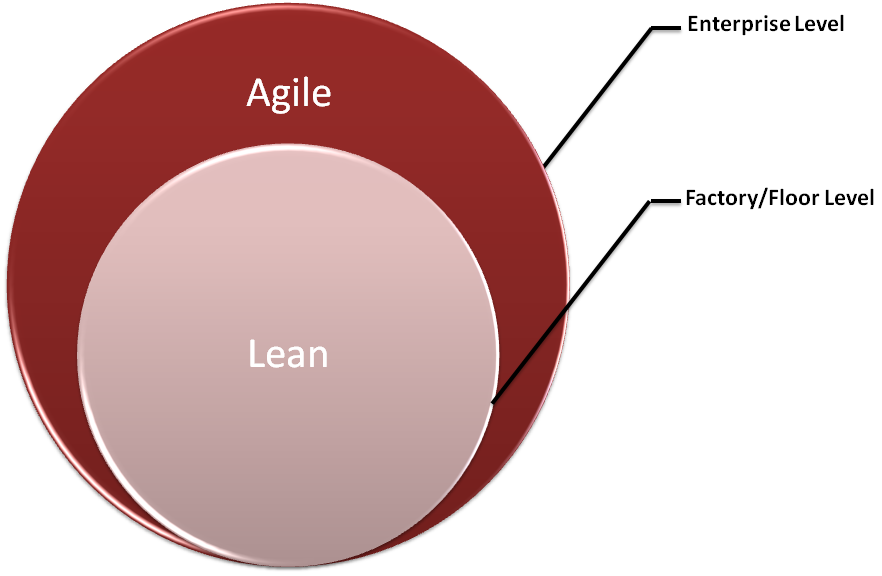
It was in 1989, that for the first time the world was introduced to the term ‘lean production’ as it was coined in by MIT. On the other hand, Agile Manufacturing can trace its origins in a research study by Lehigh University in the early 90s.
Before discussing lean and agile, it’s important to place lean manufacturing in context with the traditional mass production principles. Lean manufacturing does away with many of the manufacturing principles, and guidelines of mass production. A brief comparison is tabled below:
Mass production |
Lean Production |
| Inventory Buffers | Minimum Inventory |
| Just in Case deliveries | Just in time deliveries |
| Acceptable Quality Level | Perfect first time Quality |
| Taylorism | Worker Teams and Worker Involvement |
| Maximum efficiency | Flexible production systems |
| If ain’t broke, don’t fix it | Continuous improvement |
| Minimum waste |
Adapted from Mikell P. Groover’s Automation, Production Systems, and Computer Integrated Manufacturing, 2nd Edition
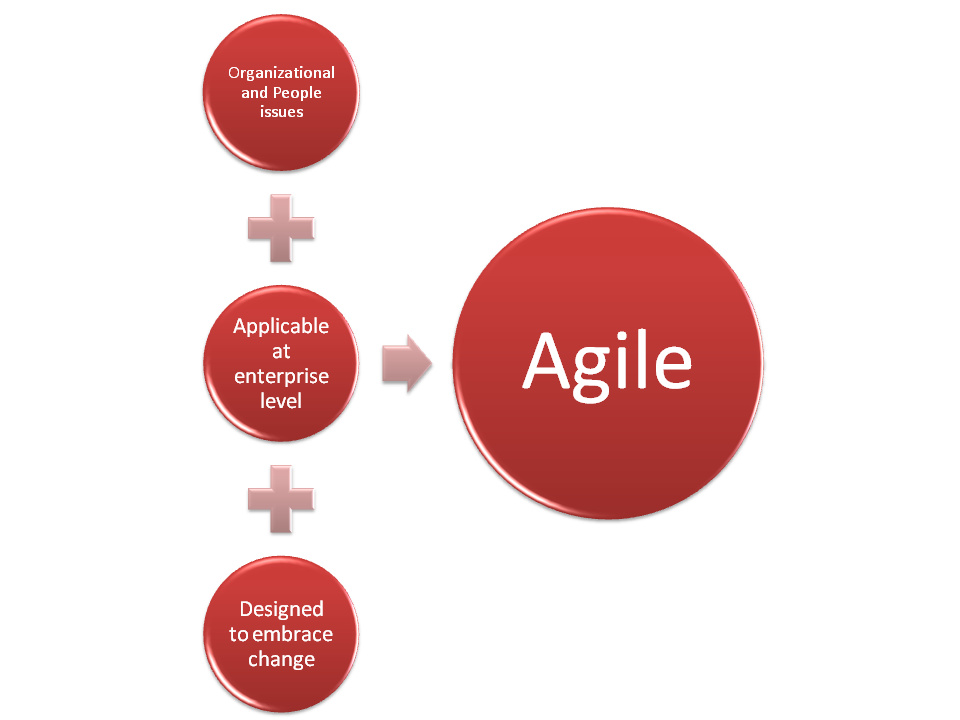
Although, tabled nearly at the same time as Lean Manufacturing, it is indeed Agile manufacturing which is far more relevant to the North American manufacturers at the enterprise level, than the former. Reason is simple enough; today many North American manufacturers are primarily focused on producing customized solutions as per client specs and in small to medium sized batches. Today quantities as little as 500 to 1000 pieces of practically any product can be outsourced to offshore vendors with considerable cost advantage.
It is important to remember that lean allows for waste free, efficient system that adds to the bottom line and in turn give competitive pricing advantage. However, most customers today come to local manufacturing facilities for their ability to quickly adapt to changes, better technical support, shorter time to market and most importantly, short production runs. Consequently, absolute focus on lean production may not be suitable for most local manufacturers and application of agile manufacturing principles on the enterprise level is important to maintain competitive against local and overseas competition.
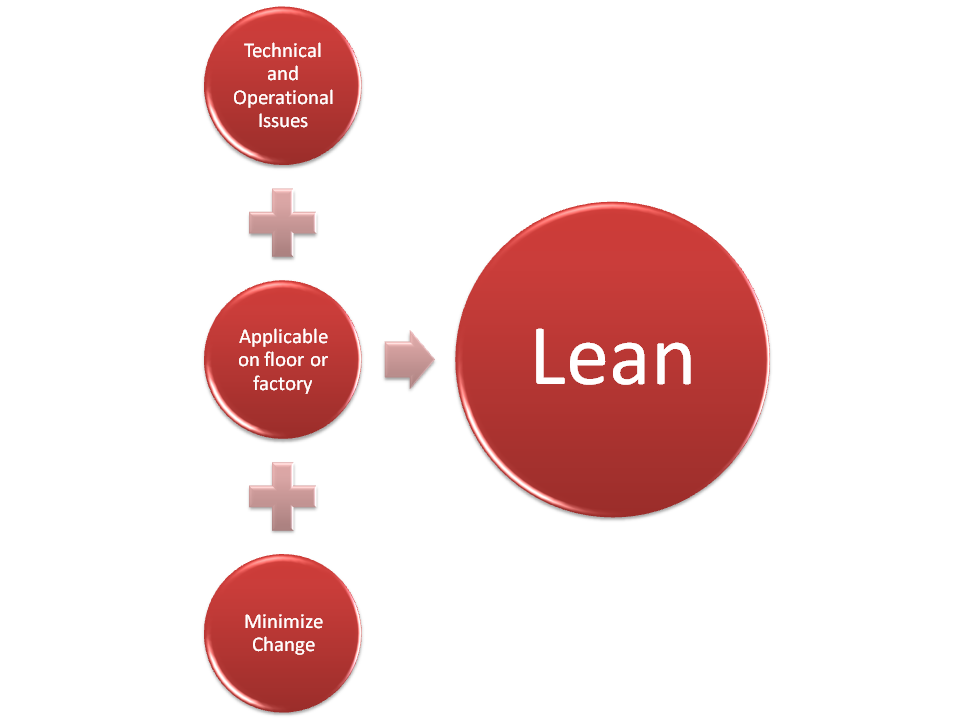
Lean and agile principles complement each other, however, the scale at which they are applied are different. Lean principles are best applied at the factory or floor level where efficiency takes precedence of all except safety. On the other hand, agile principles are most suitable at the enterprise level where ability to adjust to changing internal and external factors is off utmost importance. The emphasis in lean is more on the technical and operational issues, while agile addresses the people and organizational issues.
However, where there is a significant difference is how change management is performed under each system. Lean tries to minimize change, whether internal or external in order to minimize waste and increase efficiency. Whereas, agile embraces change. The idea is to thrive at the ever changing environment and business landscape.
In fact, agile manufacturing should be seen as the natural extension and evolution of the lean principles.
Four Principles of Lean Production and Agile Manufacturing
Lean Production |
Agile Production |
| Minimize Change | Enrich the Customer |
| Perfect first-time quality | Cooperate to enhance competitiveness |
| Flexible production lines | Organize to master change |
| Continuous improvement | Leverage the impact of people and information |
Adapted from Mikell P. Groover’s Automation, Production Systems, and Computer Integrated Manufacturing, 2nd Edition
Comparison of Lean Production and Agile Manufacturing Attributes
Lean Production |
Agile Production |
| Enhancement of Mass Production | Break with mass production; emphasis on mass customization. |
| Flexible production for product variety | Greater flexibility for customized products |
| Focus on factory operations | Scope is enterprise wide |
| Emphasis on supplier management | Formation Virtual enterprises |
| Emphasis on efficient use of resources | Emphasis on thriving in environment marked by continuous unpredictable change |
| Relies on smooth production schedule | Acknowledgement and attempts to be responsive to change. |
Adapted from Mikell P. Groover’s Automation, Production Systems, and Computer Integrated Manufacturing, 2nd Edition
Customcable.ca Launched to better serve Custom Cable Clients
After the success of cable5.ca and increase number of custom cable clients, MSASH Inc has launched its all new and improved website dedicated to custom cable assemblies.
The new website is to feature a number of direct RFQ order forms for D Sub Cables, Fiber optic cables, Networking Cables, Cisco Cables, coaxial cables and many more. The website will ultimately build a large knowledge base of Cable and Wire related topics, glossary terms and tools.
The new website also showcases some of the work MSASH Inc has performed for our customers over the years in the gallery section.